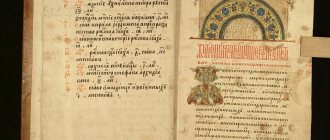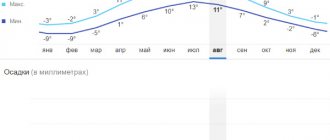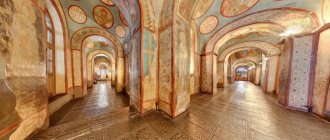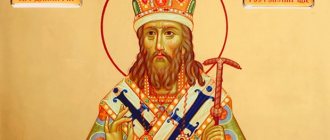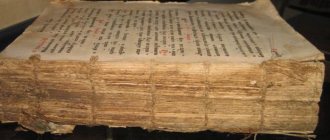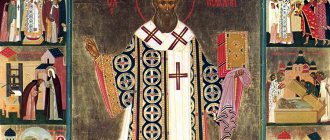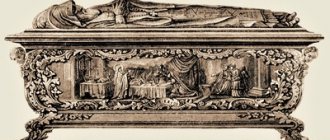Four Menaions
(cheti - other Russian: for reading, menaia - from the Greek μήν: month) - collections containing, unlike menaia, not liturgical texts, but texts for reading, also arranged by months and days of the year and intended primarily for non-liturgical use.
The Menaion Chetia contain enormous hagiographical and church teaching material, covering a significant part of the reading circle of Ancient Rus'.
The beginning of the formation of the Chetya Menaion in Rus' dates back to pre-Mongol times; the first Chetya Menaion contain mainly translated material, although, apparently, it was also possible to include Russian works (in the Assumption Collection, a manuscript of the 12th century, which can be considered as the Chetya Menaion for May month, the Legend of Boris and Gleb and the Life of Theodosius of Pechersk are placed). A certain processing of the mines was carried out at the end of the century. (this stage has not yet been sufficiently studied).
Great Fourth Menaion
In the middle of the 16th century. The Great Menaion of the Chapel of Metropolitan Macarius appears, a kind of collection of all the literature of Ancient Rus', in which the author, even when he was Archbishop of Novgorod, “collected all the books of the Russian land,” i.e. almost all works of church-narrative and spiritual-educational literature of ancient Rus'; Almost every life or legend is followed by “teachings” or words adapted for reading on the day of remembrance of this or that saint, and entire collections of the words of St. fathers, as well as works of a secular nature, for example, the Old Russian translation of Kozma Indikoplov and others. These additional parts may include entire collections of patristic works, for example, on the day of remembrance of St. Dionysius the Areopagite (October 3) provides the entire corpus of Areopagite writings in the translation of the Serbian monk Isaiah.
The Great Menaions of the Chetya are known hitherto in four lists: a) from the Moscow Assumption Cathedral, now stored in the Moscow Synodal Library (the only complete list); b) the so-called “royal” list, written for Tsar John IV, without March and April. Description of them by Gorsky and Nevostruev with additions by E.V. Barsov, in “Readings of the Moscow History Society”, 1884; c) the list of the Sofia Library and d) the list of the Chudov Monastery - both are incomplete. The publication of these M. was undertaken by the Imperial Archaeographic Commission, but so far only the months of September and October have been published (through the works of P. I. Savvaitov and M. O. Koyalovich).
Chetya Menaion of German Tulupov and priest. Ioanna Milyutin
In the 17th century The chety-menaia were compiled by German Tulupov (in 1627-1632) and priest John Milyutin (in 1646-1654) - manuscripts, the first in the library of the Sergius Lavra, the second in the synodal library in Moscow [1]. Detailed description of M. Milyutin in “Readings in the Society of Lovers of Spiritual Enlightenment”, 1868, book. IV.
Chety Menaion of St. Dimitry of Rostov
At the end of the 17th century. The compilation of four menaia is undertaken by St. Dimitry Rostovsky. His Menaion Chetia were published in quarters from 1689 to 1705. They included only the lives of saints and were compiled on the basis of the Great Menaion Chetia of Metropolitan Macarius, the Acta Sanctorum published by the Bollandists, and a number of other sources. This work has the beginnings of historical criticism.
For three hundred years after the creation of the Chetyih-Menya, St. Demetrius, Met. Rostovsky, a whole series of ancient handwritten lives and chronicles were discovered and introduced into scientific circulation, the existence of which at the turn of the 17th-18th centuries. was not known. Already in the 1st half. XIX century St. Filaret (Drozdov), Metropolitan. Moskovsky, raised the question of the need for significant additions, and in a number of cases, the compilation of new texts for the Chety-Menya lives of those saints, information about which was enriched thanks to hagiographic and historical research. It is important to note that the tradition of adding Chetyih-Menya has always existed in Russian hagiography. Finishing the last, fourth volume in three summer months, St. Demetrius was already preparing corrections and additions to the second edition of the first volume. In a remarkable study dedicated to St. Demetrius, Rev. Alexander Derzhavin wrote that “the saint had the intention to take a rather broad approach to correcting and adding to his books,” but due to illness and death, he only managed to make additions to the first volume of the Chetyi-Menya [2]. After the death of St. Demetrius Chetya-Minea were supplemented by the life of St. himself. Demetrius, and the lives of Saints Equal-to-the-Apostles Constantine and Helena - information from such an important primary source as the book of Eusebius Pamphilus “The Life of Blessed Basileus Constantine”. A number of texts in the Chetya-Minea were subjected to similar modifications.
All chety-menaia of the 18th-19th centuries. are cheti-menaions of St. supplemented with one material or another. Dimitri. The book was reprinted and revised many times, enjoying enormous popularity among the Orthodox population of Russia.
Other devotees in this field
Later, in the 17th century, attempts to write church books for non-liturgical reading continued. Thus, M. Milyutin in the spiritual scientific and literary magazine “Readings in the Society of Lovers of Spiritual Enlightenment,” published until 1871, meticulously describes the Chetya Menaion of the priest of the Church of the Nativity John Milyutin, which he wrote together with his three sons from 1646 to 1654. They are kept in the Moscow Synodal Library. Considers M. Milyutin and the Fourth Menaion of Hieronymus of the Trinity-Sergius Monastery, professional scribe and scribe German Tulupov, written by him in 1627-1632 and stored in the library of the Sergius Lavra.
Literary feat of Macarius
But already in the 16th century the above-mentioned Great Chetya Menaion of Macarius appeared. In addition to translated texts, they contain original accompanying materials - patristic teachings and apocrypha, sometimes very voluminous. They, as a rule, coincided with the days of remembrance of one or another saint. The Chetya Menaion of the Moscow Assumption Cathedral, one of four known today, is the only one that has been completely preserved. It is kept in the synodal library of the cathedral. The remaining three Menaion Chetya are incomplete lists. A Menaion was written for Ivan the Terrible, in which March and April are missing. The other two are lists of the Chudov Monastery and the Sofia Library. These are the only 4 lists representing the Great Chetya Menaion of Archbishop Macarius of Novgorod, later Metropolitan of Moscow, that have survived to this day.
tonsure and abbess
While still a very young man, Daniel decides to go to a monastery. The parents did not create any obstacles in this choice of their son and gave their blessing, because they saw that this was exactly the path prepared by the Lord for their child. And the young man Daniel leaves home for the Kirillov Monastery. The rector of the monastery is the former rector of the school where Daniil studied, so the young man is greeted warmly at the monastery.
Saint Demetrius of Rostov
And then, in 1668, the most long-awaited event in Daniel’s life came—he was tonsured. The father abbot himself performed it, and named the new monk Demetrius. The newly minted monk immediately began to zealously fulfill the monastic rule, choosing Saints Anthony and Theodosius, as well as the rest of the Pechersk ascetics, as his example.
Important! Even as a monk, Father Dimitri did not abandon his studies and scientific research in his cell.
7 years after the first tonsure, Father Dmitry met with the then Metropolitan of Chernigov. Seeing that before him was a talented and zealous servant of the Lord, the bishop invited the monk to preach in the Chernigov diocese. There he quickly earned the love of ordinary people and church ministers. Many monasteries and large parishes began to invite Father Dmitry to listen to his edifying sermons. The power of his word was such that many people believed in the Lord.
Having visited a large number of monasteries and met many church hierarchs, Father Dimitri receives an invitation from the brethren of the Kirillov Monastery to become their abbot. The archbishop without hesitation approves the inspired monk, and Father Dimitri becomes abbot.
Subsequently, by the Providence of God, he will head more than one monastery, and in every place Saint Dmitry will be an example for all the brethren. A strict ascetic life, asceticism, and at the same time a lively participation in the life of every person made him a favorite abbot in every monastery.
About Orthodox monasteries:
- Mother of God Assumption Monastery in Tikhvin
- Joseph-Volotsky Monastery in Moscow
- Zadonsky Tikhonovsky Transfiguration Monastery in the Lipetsk region
Other works of the holy ascetic and his spiritual gifts
Having the experience of writing a large church work, Metropolitan Demetrius decided to write another book telling about the events of the Bible. The fact is that at that time the Bible in the Slavic language was very rare and was very expensive. Therefore, the majority of the common population could not afford such luxury and were deprived of the grace-filled reading of the Holy Scriptures. Moreover, even many of the priesthood had a poor understanding of biblical events and confused chronology.
Icon of Demetrius
Saint Demetrius begins a new work. In it he uses the main biblical events and plots, and ascribes teachings and interpretations to them. By reading this work, even a person completely unfamiliar with the Bible could form a clear idea of the Holy Scriptures. Unfortunately, the saint was never able to complete this great work due to his very poor health.
In addition to writing books, the ascetic spent his entire life preaching the faith of Christ. Possessing a unique gift of speech, he knew how to structure his speech in such a way that no one who heard them remained indifferent. Since most often his listeners were ordinary people, he structured his sermons simply, like a conversation between a father and his beloved children. And no matter what labors and worries fell to the lot of the ascetic, he never abandoned the feat of preaching until the very last days of his life.
One of his ascetic deeds was prayer, which he never abandoned. Trying to be in church every day, he served the liturgy on every Sunday and church holiday. He taught everyone who was in his immediate circle to pray constantly and earnestly, remembering the Lord every minute.
Interesting! The fast of the ascetic was also very strict. So, during Holy Week he ate only once - on Maundy Thursday.
Of course, such a deep spiritual life also affected his earthly life, his communication with people. With everyone whom Dmitry Rostovsky ever met, he was attentive and courteous. All his life he helped the poor and suffering - some with words of consolation, and some with money. Saint Demetrius was distinguished by extreme non-acquisitiveness; he was always content with only the necessary minimum of goods for himself, and distributed the rest to those in need.
The result of such an attentive attitude to one’s own soul was the acquisition of the greatest humility. The ascetic always remembered the words of the Lord that whoever wants to be first in the Kingdom of Heaven must be last in earthly life. In the life of Metropolitan Demetrius, this commandment was embodied in deep respect for any superiors, mercy for subordinates, and compassion for the grieving.
